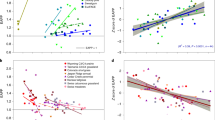Abstract
The need to combine data from CO2 field experiments with climate data remains urgent, particularly because each CO2 experiment cannot run for decades to centuries. Furthermore, predictions for a given biome need to take into account differences in productivity and leaf area index (LAI) independent of CO2-derived changes. In this study, we use long-term weather records and field data from the Jasper Ridge CO2 experiment in Palo Alto, California, to model the effects of CO2 and climate variability on ecosystem water fluxes. The sandstone and serpentine grasslands at Jasper Ridge provide a range of primary productivity and LAI, with the sandstone as the more productive system. Modeled soil water availability agreed well with published observations of time-domain reflectometry in the CO2 experiment. Simulated water fluxes based on 10-year weather data (January 1985–December 1994) showed that the sandstone grassland had a much greater proportion of water movement through plants than did the serpentine; transpiration accounted for approximately 30% of annual fluxes in the sandstone and only 10% in the serpentine. Although simulated physiological and biomass changes were similar in both grasslands, the consequences of elevated CO2 were greater for the sandstone water budget. Elevated CO2 increased soil drainage by 20% in the sandstone, despite an approximately one-fifth increase in plant biomass; in the serpentine, drainage increased by <10% and soil evaporation was unchanged for the same simulated biomass change. Phenological changes, simulated by a 15-day lengthening of the growing season, had minimal impacts on the water budget. Annual variation in the timing and amount of rainfall was important for water fluxes in both grasslands. Elevated CO2 increased sandstone drainage >50 mm in seven of ten years, but the relative increase in drainage varied from 10% to 300% depending on the year. Early-season transpiration in the sandstone decreased between 26% and 41%, with elevated CO2 resulting in a simulated water savings of 54–76 mm. Even in years when precipitation was similar (e.g., 505 and 479 mm in years 3 and 4), the effect of CO2 varied dramatically. The response of grassland water budgets to CO2 depends on the productivity and structure of the grassland, the amount and timing of rainfall, and CO2-induced changes in physiology. In systems with low LAI, large physiological changes may not necessarily alter total ecosystem water budgets dramatically.
Similar content being viewed by others
Author information
Authors and Affiliations
Additional information
Received: 11 March 1997 / Accepted: 23 September 1997
Rights and permissions
About this article
Cite this article
Jackson, R., Sala, O., Paruelo, J. et al. Ecosystem water fluxes for two grasslands in elevated CO2: a modeling analysis. Oecologia 113, 537–546 (1998). https://doi.org/10.1007/s004420050407
Issue Date:
DOI: https://doi.org/10.1007/s004420050407




